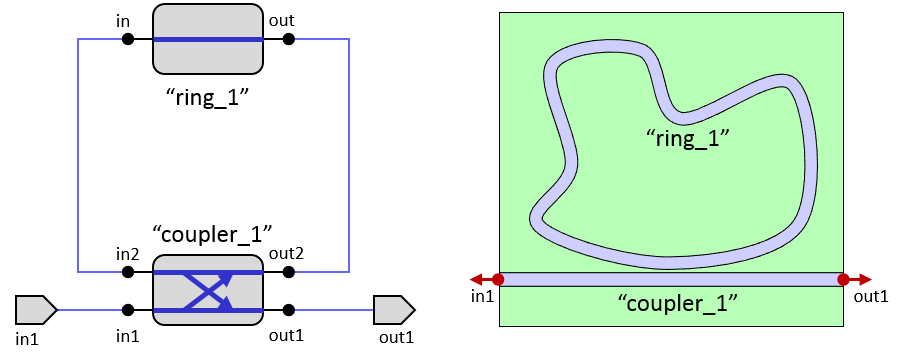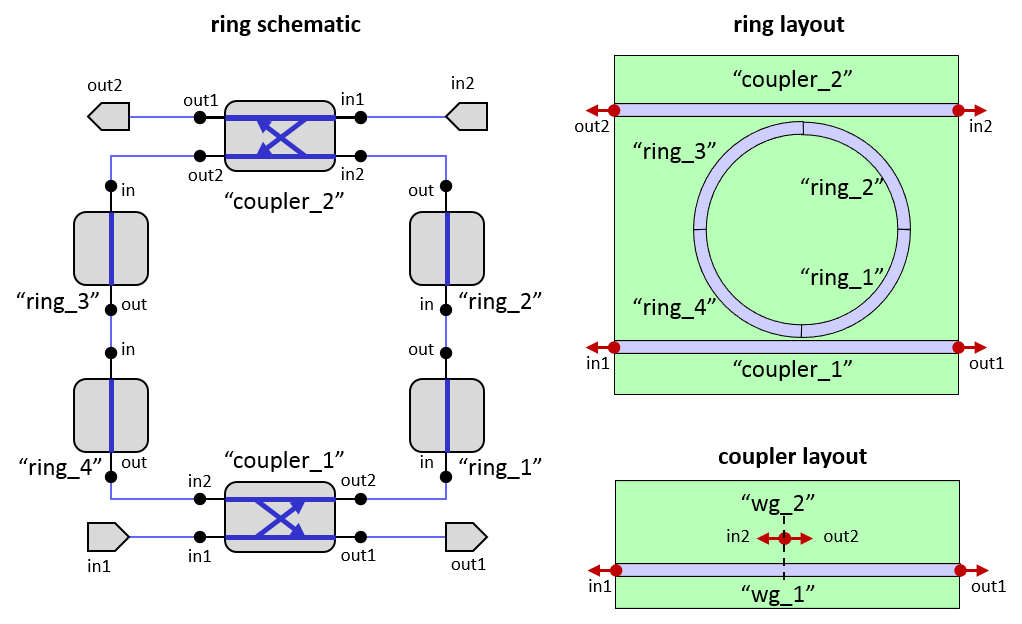Ring Resonators
Ring resonators are a group very common and versatile components, used for wavelength filtering, optical modulation, nonlinear functions and sensing applications. While the basic principle of ring resonators are easily defined, there are many variations of ring resonators, with different coupling geometries and ring shapes.
PICAZZO provides a set of predefined ring resonators for the most common geometries, with both a single coupling section (all-pass filters) or two coupling sections (channel drop filters). These components are parametric and allow you to modify the bend shape, the coupler geometry etc.
These commonly used rings are based on a set of very generic ring resonator building blocks, which expert users can use to construct really custom rings. This is done by defining the parts of the ring in a generic way
The ring segments (which are usually one or more waveguide PCells)
The couplers
The placement of the couplers (transformations)
By combining these three elements, many different classes of rings can be made. For example, the class
RingRectSymm90DropFilter is derived from the following base classes:
_RingHasSymmetricWaveguideCouplers: this provides symmetric coupling sections, which mirror shape of the ring_Ring2CouplerTransformation90: this places a coupling section at the south side of the ring, and another at the east sideRingRect: This generates a rectangular ring.
Hierarchy of the ring circuit and layout
The figure below illustrates the internals of a generic ring, which could be based on the RingRoundedShape class.
It has a single ring segment with a somewhat bizarre shape, and it also has a straight coupler waveguide.

We see that the coupler section in the layout consists of a single waveguide, while in the schematic it is represented by a 2x2 coupler. The standard coupling sections of the ring resonator are based on directional couplers, but with the length of the second waveguide set to zero.
The most common type of ring is the rounded rectangular ring, which is defined in the PCell class RingRect and
its derived classes with different coupling sections. Circular and Racetrack rings are just special cases of this type
of ring, setting the straight sections to zero length.
For efficiency, these rectangular rings are defined in 4 ring segments, or quadrants. This is illustrated in the figure below where we have a circular ring with 2 straigth coupler sections.

Coupler sections
The different types of couplers are:
Straight: a straigth waveguide with an offset from the ring
Symmetric: Mirroring the bend of the ring
Wrapped: Following the contour of the ring over a given angler coverage
S-Bend: Mirroring the shape of the ring over a certain angular coverage and then bending back to the horizontal directions.

Of course, it is possible to create your own coupling sections to create new types of rings.
Coupler positioning
Three different configurations of couplers are predefined
Notch: A single coupler (a notch filter or all-pass filter)180Drop: A channel drop configuration with 2 couplers at the north and south, 180 degree rotated width respect to each other90Drop: A channel drop filter with the first coupler at the south and the second coupler at the east side of the ring.

Circuit model
The circuit model for the ring is derived from the netlist. But as the examples in the Ring classes show, it is necessary to specify the relevant model parameters yourself, as they are not automatically calculated from the layout.
Ring Resonator made of a single trace along an arbitrary shape. |
|
Ring Resonator where the ring itself is made of an arbitrary a set of traces. |
|
A ring resonator based on a rounded shape, without couplers. |
|
A Ring resonator consisting of a rounded rectangular trace. |
|
Rectangular Ring resonator with one straight bus waveguide, which is placed on the South side of the ring. |
|
Rectangular ring filter with two straight access waveguide. |
|
Rectangular ring filter with two straight access waveguide. |
|
Rectangular Ring resonator with one bus waveguide, which is placed on the South side of the ring. |
|
Rectangular ring filter with two access waveguides. |
|
Rectangular Ring resonator with one bus waveguide, which is placed on the South side of the ring. |
|
Rectangular ring filter with two access waveguide. |
|
Rectangular ring filter with two access waveguide. |
|
Rectangular Ring resonator with one bus waveguide, which is placed on the South side of the ring. |
|
Rectangular ring filter with two access waveguides. |